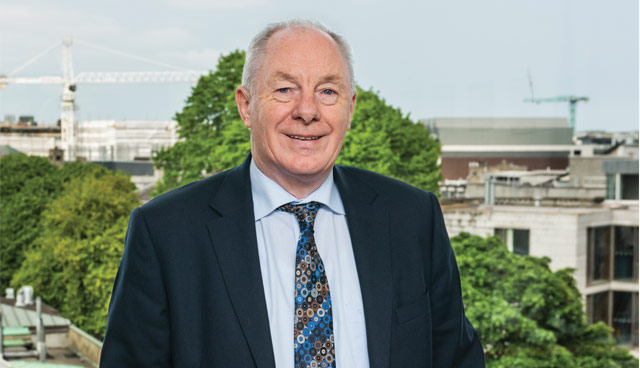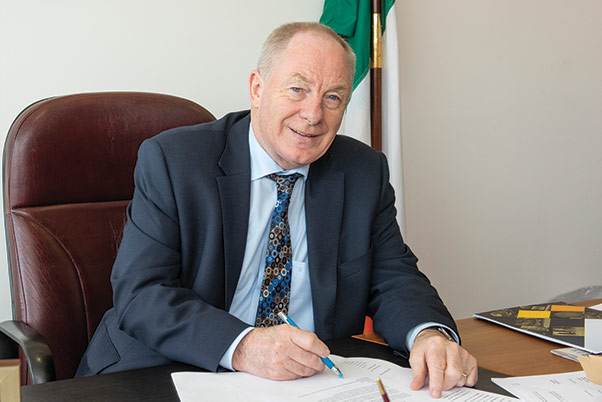Rural and Community Development Minister Michael Ring, TD


In June 2017, Michael Ring, TD was appointed to cabinet as Minister of the newly established Department of Rural and Community Development (DRCD). Ciarán Galway visits the Department’s new headquarters on Leinster Street to speak with the Minister about the progress made over the last 12 months.
What was the rationale for establishing the Department and why were you selected for appointment to the portfolio?
In 2017, the Taoiseach, Leo Varadkar decided to establish a Department of Rural and Community Development. The rationale behind that was, in the previous election the Government lost a significant number of seats in rural Ireland and with the economy having improved, people felt that rural Ireland was being left behind. I have to say, it was a brave decision, a good decision and a decision that was well received all over the country because people felt that there was somebody there now representing rural Ireland.
It’s a priority [for the Government] to the extent that there is now a minister sitting at the Cabinet table. We never had a dedicated minister for rural and community development in the past and we are already seeing dividends from it.
My brief is rural and community development. I am someone who was born and reared in rural Ireland. I know and have a feel for rural Ireland. Likewise, over the years I came through the ranks of the town and the county council and I have now been in the Dáil for the last 24 years, so I understand the needs of communities. I am the right person, in the right place and at the right time.
As a relatively young department, what specifically is DRCD doing to cultivate and support sustainable and inclusive community development?
The DRCD was established as a completely new department and that in itself is a very difficult thing to do. As well as setting up the Department, we moved location twice in the year. I must compliment my staff, they worked under very difficult circumstances and under intense pressure, but they all responded and were invaluable for the new department.
I now have a new Secretary General, Kevin McCarthy, and new assistant secretaries and we are well established. It was a very difficult time for everyone, including myself, because I was expected to function as a minister, administer the schemes, while being housed in temporary accommodation on two occasions. In that year, we rolled out the Town and Village Renewal Scheme, the Rural Recreation Scheme, the Local Improvement Scheme, the Community Services Programme and the RAPID Programme. We did that under difficult circumstances and I couldn’t thank my staff enough for the work, the commitment and the effort they poured into it.
A key objective is to bring about a more coordinated approach to publicly funded local and community development interventions. The key means of doing this is through the Local and Community Development Committees (LCDCs) and the Local Economic and Community Plans.
Likewise, the SICAP programme is being delivered at a local level and implemented by Local Development Companies. As well assisting individuals, these companies work to build the capacity of local community groups so that those groups can then actively improve the lives of people in their communities by addressing the social exclusion issues that affect them.
In addition, my Department is currently preparing a new National Policy on Social Enterprise. Social enterprises are set up to deliver or contribute towards a social, community or environmental goal and the surpluses which emerge are reinvested back into the aforementioned goal of the social enterprise.
As Minister, what are your most pressing priorities with regards to community development and what are the unique challenges of the portfolio?
The Community Services Programme was transferred to my Department in January this year. My current priority is to maintain the level of service for the organisations currently funded under the programme and to monitor its progress over the coming months. After this point, the Department will undertake a thorough review commencing in early autumn.
“One of the main challenges is to reach out and support those communities which are still experiencing disadvantage through poverty, social exclusion, or due to their geographic location.”
With the unemployment rate down to 5 per cent, there is more of an opportunity to target the communities that need it most. One of the main challenges is to reach out and support those communities which are still experiencing disadvantage through poverty, social exclusion, or due to their geographic location.
The community schemes, particularly the CLÁR programme and the Town and Village Scheme, have all created jobs, but they have also produced a positivity in rural Ireland. There are towns and villages which drew down funding in the last year and the rewards are being reaped already in relation to the investment.
The SCICAP programme is aimed at targeting unemployed people, people living in deprived areas and people living with disability. Under the last SCICAP programme, between 2015 and 2017, 110,000 people were supported on a one-to-one basis. 5,030 local community groups were supported. We had 9,700 people who gained a qualification in higher education and 5,801 people got jobs and that’s the key. The more jobs that we can create then the more people we can remove from disadvantage. 38,352 people took part in a life-long learning course.
How has engagement between national and local government and local communities been improved?
I have a working relationship with every department and a good working relationship with the local authorities, but the best working relationship I have is with communities themselves, because I go around the country, I listen to communities, I hear their problems and their needs, and while I cannot resolve everything they ask of me, at least I am listening. I know what is required and what is needed.
Since the publication of Putting People First and local government reform, there has been an increased engagement between my Department and local government in the context of local development and community development on both the policy and the structures side.
My officials have regular meetings with the Local Government Management Agency, but I also meet them myself. We engage on all aspects of local and community development and I have also outlined my plans for the future, particularly in relation to funding. The local authorities which had a capacity problem in delivering some of the schemes simply did not have sufficient funding in recent years. Now they will be rolling the funding out on a year-to-year basis.
Under the LIS programme, last year we spent €17 million, this year we spent €10.5 million and that is to help people in rural areas to have access to a decent road to and from their house. These are people are paying who are paying their property charges and their taxes and feel that they entitled to such access.
In relation to the Town and Village Scheme, go to Drumshambo [County Leitrim] where we supported the digital hub and put funding into the Rural Recreation scheme which facilitated the establishment of eight new companies. It is creating employment and it is creating jobs. It’s also bringing visitors into rural Ireland.

A National Strategic Outcome of the National Planning Framework is strengthened rural economies and communities. What does this mean?
Supporting rural development is a key priority for this government. The biggest achievement in the last year is the National Development Plan. I played a major role in talking to all government departments and the Finance Minister – to ensure the infrastructure required for the future. The €1 billion Rural Regeneration and Development Fund is a commitment to fund rural development over the next 10 years. It will support projects and schemes that can help develop the rural economy and drive job creation. The objective is to drive collaborative, coordinated and complementary packages of investment between departments, agencies, local authorities and other public bodies, to transform our rural towns and villages and their outlying areas.
“I have no doubt that the tide has turned on rural job creation. You can see it in every corner of the country now. Go to any corner, whether in Kerry or Mayo, and there are multinational companies alongside our own indigenous companies and many, many people are being employed.”
What we have done in relation to a lot of these programmes, particularly the LCDCs, is bring all the communities from around each county, with the county councils, people from the health, education and community sectors, and they are making decisions for themselves. Who knows better what each county needs than the people living and working there. This is why the LCDCs and the PPNs are working well, because they understand what is needed. They understand what is needed, they understand the problems that are present.
That’s why, I’m looking at the RAPID programme and the Communities programme and hoping to merge them and the LCDCs will make the actual decisions about where funding is required and targeted. The more you bring it down to the community, the better things work. Who knows better what communities need than communities themselves.
Sometimes what happened in the past was that people made decisions externally and then forced them on the communities, now we have communities making decisions and working with local authorities. To be fair to the local authorities, they are on the ground and that’s there strength. They’re working and dealing with local communities every day. It’s great to have them under the same umbrella and working together.
How are communities that are vulnerable and/or disadvantaged being empowered?
The major scheme is the Social Inclusion and Community Activation Programme (SICAP), because it is delivered and targets disadvantage and social exclusion at a local level by Local Development Companies. As well as assisting individuals, these companies work to build the capacity of local community groups so that they can actively improve the lives of people within their communities.
The Community Services Programmes focuses on communities where public and private sector services are lacking, either through geographical or social isolation or because of demand deficits. It supports community business and social enterprises to deliver local services and employment opportunities.
I have no doubt that the tide has turned on rural job creation. You can see it in every corner of the country now. Go to any corner, whether in Kerry or Mayo, and there are multinational companies alongside our own indigenous companies and many, many people are being employed. Last year, according to CSO figures, 84 per cent of the jobs created were outside of Dublin. Of course, we want and need more jobs in rural Ireland, that’s my job in Government – I make every minister accountable to rural Ireland on a regular basis. That’s why it was a good decision to have somebody representing rural and community development at the Cabinet table.

What is your vision for the future of rural Ireland and community development across the country?
We have very talented and highly skilled people living and working in rural Ireland. I think there is a bright future. The one piece of infrastructure that we really require – and we’re rolling out – is broadband. The more broadband that we roll out and the more communities that gain access, the better opportunity there is to attract jobs to rural areas. Even as it is, I am pleased with the amount of companies that are employing people in rural Ireland. We don’t give enough recognition to indigenous Irish companies which are creating the 20, 30 or 50 jobs in their communities. To me, every single job created in rural Ireland has a value. The more people that you have working in rural Ireland, then the more people you have living in rural Ireland, sustaining local communities. That’s what it’s all about and that’s my plan for the future.
We’re pleased about the number of schemes that we have rolled out over a very short time in the last year. I am invited every day to see completed schemes and what people have achieved. Very simple things have had a major effect. Take for instance the Seniors Alert Scheme. For the three previous years before that, the funding that we had put in place wasn’t drawn down. This year, we’re going to have a major overspend because we went out, we met the communities and we formulated a new scheme. A lot more people in this country now feel happier and safer in their country.
Another example is the Tidy Towns competition – one of the greatest initiatives which was ever formed in this country. This is the 60th year of the tidy towns this year and I make a call to every community group, whether they be sporting, cultural or artistic, to make a special effort to make a contribution to Tidy Towns.





